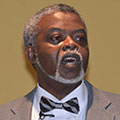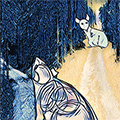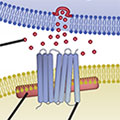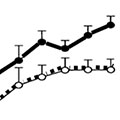Reviews To Read – January 2019. Although some of the clinical manifestations of substance use disorders might be superficially similar, it is highly likely that different classes of abused drugs including opioids (heroin, morphine, and oxycodone, other opioids) and psychostimulants (cocaine and amphetamines) cause different neuroadaptations in various brain regions dependent in the distribution and concentration of their biochemical… [Read More]
News Main
AP-MALDI Mass Spectrometry Imaging of Gangliosides Using 2,6-Dihydroxyacetophenone.
Featured Paper of the Month – January 2019
Published in Journal of the American Society for Mass Spectrometry by Jackson, Shelley N; Muller, Ludovic; Roux, Aurelie; Oktem, Berk; Moskovets, Eugene; Doroshenko, Vladimir M; Woods, Amina S
Gangliosides are complex glycosphingolipids and have been implicated in brain development, neuritogenesis, memory formation, synaptic transmission and aging. Disruptions in ganglioside metabolism has been linked to several diseases such as Niemann-Pick C, and Gaucher disease types II, Alzheimer disease and Guillain-Barre syndrome. GD1s are the most abundant ganglioside species in the mammalian brain and consist of two structural isomers, GD1a and GD1b.Traditionally, the only way to analyze these isomers by mass spectrometry involved extraction and thus the researcher loses information about the location of the isomers in tissue…
NIDA IRP Welcomes Brenda Curtis, Ph.D.
NIDA welcomes Brenda L. Curtis, PhD who joined the IRP on January 7th as a new Investigator (Tenure-Track) within the Clinical Pharmacology & Therapeutics Research Branch (CPTRB). Dr. Curtis will lead a cutting-edge clinical research program as the Principal Investigator of the Technology and Translational Research Unit. Dr. Curtis earned both a bachelor’s degree in… [Read More]
Ventral midbrain astrocytes display unique physiological features and sensitivity to dopamine D2 receptor signaling.
Featured Paper of the Month – December 2018
Published in Neuropsychopharmacology by Xin, Wendy; Schuebel, Kornel E; Jair, Kam-Wing; Cimbro, Raffaello; Biase, Lindsay M De; Goldman, David; Bonci, Antonello
Astrocytes are ubiquitous CNS cells that support tissue homeostasis through ion buffering, neurotransmitter recycling, and regulation of CNS vasculature. Yet, despite the essential functional roles they fill, very little is known about the physiology of astrocytes in the ventral midbrain, a region that houses dopamine-releasing neurons and is critical for reward learning and motivated behaviors. Using a combination of whole-transcriptome sequencing, histology, slice electrophysiology, and calcium imaging, Xin et al. performed the first functional and molecular profiling of ventral midbrain astrocytes and observed numerous differences between these cells and their telencephalic counterparts, both in their gene expression profile and in their physiological properties…
Genetic deletion of vesicular glutamate transporter in dopamine neurons increases vulnerability to MPTP-induced neurotoxicity in mice.
Hot Off the Press – November 29, 2018. The neural mechanisms underlying dopamine neuron degeneration in Parkinson’s disease are largely unknown. In this study, we found that selective deletion of a vesicular glutamate transporter (VgluT2) in dopamine neurons led to a significant increase in dopamine neuron toxicity to the neurotoxin MPTP via a BDNF-dependent mechanism,… [Read More]
Science-Based Actions Can Help Address the Opioid Crisis.
Reviews To Read – November 29, 2018. This commentary on the opioid crisis was written by two NIDA IRP investigators (clinical investigator David Epstein and preclinical investigator Yavin Shaham), along with former Clinical Director Markus Heilig. It challenges misconceptions about the nature of the crisis, and it suggests solutions that are–as the authors say–“probably not… [Read More]
Volitional social interaction prevents drug addiction in rat models.
Hot Off the Press – November 19, 2018. A new study published in Nature Neuroscience finds that social interactions can have a profound effect on behaviors related to addiction, and on the brain’s response to drug-associated cues. These findings have implications for people with substance use disorders (SUDs), because it suggests that social interaction can… [Read More]
Selective Brain Distribution and Distinctive Synaptic Architecture of Dual Glutamatergic-GABAergic Neurons
Featured Paper of the Month – Novermber 2018
Published in Cell Reports by Root, David H; Zhang, Shiliang; Barker, David J; Miranda-Barrientos, Jorge; Liu, Bing; Wang, Hui-Ling; Morales, Marisela
Root and Zhang et al. (from Dr. Morales’ lab) identified throughout the brain concentrated populations of glutamate and GABA co-transmitting neurons in ventral tegmental area, entopeduncular, and supramammillary nuclei. Single axon terminals from these neurons form a common synaptic architecture that co-transmit glutamate and GABA from distinct synaptic vesicles at independent asymmetric or symmetric synapses…
Cocaine reward is reduced by decreased expression of receptor-type protein tyrosine phosphatase D (PTPRD) and by a novel PTPRD antagonist.
Hot Off the Press – October 25, 2018. There are currently no effective medications available for the treatment of psychostimulant addiction. Receptor-type protein tyrosine phosphatase D (PTPRD) is a neuronal cell-adhesion molecule that has been associated with psychostimulant addiction in humans. In this research, we found that PTPRD gene mutation significantly reduced vulnerability to cocaine… [Read More]
Distinct and Dynamic ON and OFF Neural Ensembles in the Prefrontal Cortex Code Social Exploration.
Hot Off the Press – October 10, 2018. Using miniature fluorescence microscopes (miniScope) via an implanted optical microprobe, Liang and Zhang et. al. were able to record the calcium activity from hundreds of nerve cells in medial prefrontal cortex (mPFC) when the mice freely engaged in social exploration. They track the activity of the same… [Read More]










